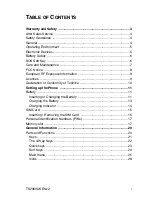
be set to the same value at all sites. It is the responsibility of the host system to insure
that additional data is not transmitted until sufficient time has elapsed to allow data to
travel to the last digipeater and the response, if any, to travel back to the host. Note that
the automatic "Time to Live" timer and the TUPTIME timer are only in effect if packets
are being digipeated.
Commands Used
Basic TUP Operation involves just a few commands:
MYCALL - The MYCALL command determines the MODEM address. This must be
entered after the autobaud routine has detected an asterisk (*).
TXDELAY - The TXDELAY (TXD) command determines how long the modem will
assert the Push-to- Talk line of the radio before sending data. This time will have to be
determined experimentally since it will vary from radio to radio. If the TXD is set too
short, the data transmitted will not be received by other units in the system. Setting TXD
too long will reduce channel capacity. NOTE: Since TXD is used in the computation of
the automatic timer used to inhibit transmission until a digipeated packet has had time
to reach its destination, TXD must be set to the same value in all modems in the system
PACTIME - The PACTIME parameter determines how long the modem will wait after
receiving data to be transmitted from the DTE before beginning the radio key-up
sequence. Normally, this parameter should be set to AFTER 1 (100 ms) in order to
minimize "dead air" time on the system.
PACLEN - PACLEN sets the maximum size of the data packet(s). Most applications do
not require large amounts of data to be transferred so the default value (128) will
probably be satisfactory, allowing packets up to 128 bytes. If the amount of data to be
sent exceeds the PACLEN parameter setting, the transmission will be composed of
multiple packets containing the data.
PERSIST and SLOTTIME - These parameters determine how aggressively the modem
will attempt to access a multi-user channel based on carrier detect. See KPC-series
manual for a full explanation of these parameters.
Entering TUP Mode
Use the INTFACE command to begin TUP operation. Set the INTFACE command to
TUP:
cmd:INTFACE TUP <cr>
and turn the unit off and then back on.
56
Содержание MT1200
Страница 2: ......
Страница 8: ......
Страница 21: ...This page left blank intentionally 13...
Страница 22: ...This page left blank intentionally 14...
Страница 25: ...17...
Страница 41: ...33...
Страница 42: ...34...
Страница 43: ...35...
Страница 156: ...MT1200 Parts Layout Top side 148...
Страница 157: ...Bottom side 149...
















































